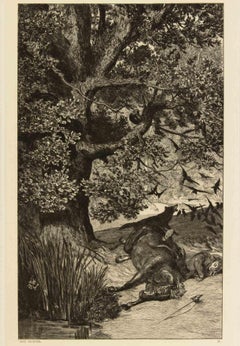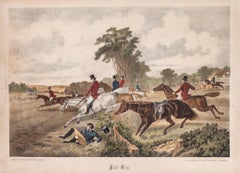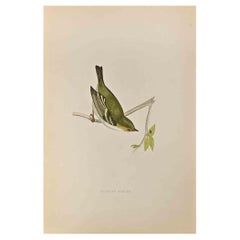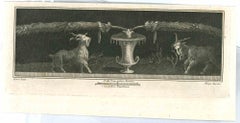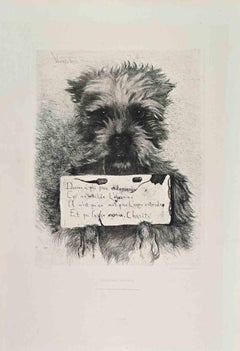Animal Figurative Prints
to
545
1,458
205
159
30
13
Overall Width
to
Overall Height
to
1,241
259
115
35
17
7
6
4
3
2
1
1
1
36
33
27
19
15
445
864
424
132
6
3
5
11
12
17
38
110
58
64
429
967
835
55
26,969
14,783
10,581
9,094
7,789
7,002
4,601
4,163
2,411
2,046
1,932
1,865
1,664
1,470
1,465
1,443
1,436
1,301
1,228
1,109
763
590
336
267
45
51
1,446
886
210
Art Subject: Animal
"Le Bal Masque" Giuseppe Verdi Opera (Variant)
Located in San Francisco, CA
This artwork titled "Le Bal Masque" Giuseppe Verdi Opera, (Variant) 1967 is an original color lithograph on Japan paper by renown Austrian expressionist artist Oskar Kokoschka, 1886-...
Category
Mid-20th Century Expressionist Figurative Prints
Materials
Lithograph
Fallen Rider - Etching by Max Klinger - 1881
By Max Klinger
Located in Roma, IT
Fallen Rider is a modern artwork realized by Max Klinger in 1881.
The artwork belongs to a series of prints called Intermezzi realized by Max Klinger, published by Nurnberg: Stroef...
Category
1880s Symbolist Figurative Prints
Materials
Etching
Riding - Original Lithograph - 19th Century
Located in Roma, IT
Riding is an original print realized by an Anonymous artists of the 19th Century.
Mixed colored lithograph.
Good conditions except for some prepared rips.
This lithograph represen...
Category
19th Century Modern Figurative Prints
Materials
Paper, Lithograph
Dalmatian Regulus - Woodcut Print by Alexander Francis Lydon - 1870
Located in Roma, IT
Dalmatian Regulus is a modern artwork realized in 1870 by the British artist Alexander Francis Lydon (1836-1917) .
Woodcut print, hand colored, published by London, Bell & Sons, 18...
Category
1870s Modern Figurative Prints
Materials
Woodcut
Ancient Roman Frescoes - Original Etching by Nicolò Vanni - 18th Century
Located in Roma, IT
Ancient Roman Frescoes, from the series "Antiquities of Herculaneum", is an original etching on paper realized from a design by Vincenzo Aloja after Nicolò Vanni in the 18th century....
Category
18th Century Old Masters Figurative Prints
Materials
Etching
Pour les Pauvres - Etching by Ludovic-Napoléon Lepic - Late 19th Century
Located in Roma, IT
Pour les Pauvres is a black and White etching realized in the Late 19th Century.
Titled in the lower
Image Size: 35x26
Very good impression.
Realized by Cadart for the "Société ...
Category
Late 19th Century Impressionist Figurative Prints
Materials
Etching
Redwing - Woodcut Print by Alexander Francis Lydon - 1870
Located in Roma, IT
Redwing is a modern artwork realized in 1870 by the British artist Lydon Alexander Francis (1836-1917)
Woodcut print, hand colored, published by London, Bell & Sons, 1870. Name of...
Category
1870s Modern Figurative Prints
Materials
Woodcut
Les Trappistes - Etching by Auguste Lancon - 1883
Located in Roma, IT
Etching and Aquatint realized by Auguste Lançon (1836-1887) in 1883. Published by A. Quantin, Paris, in an edition of 250 copies.
This Series depicts scenes from the daily life of T...
Category
1880s Modern Figurative Prints
Materials
Etching
Red-Breasted Goose - Woodcut Print by Alexander Francis Lydon - 1870
Located in Roma, IT
Red-Breasted Goose is a modern artwork realized in 1870 by the British artist Alexander Francis Lydon (1836-1917) .
Woodcut print, hand colored, published by London, Bell & Sons, ...
Category
1870s Modern Figurative Prints
Materials
Woodcut
Le Cochon de Siam ( A boar ) - Etching by Jean Gullaume Moitte - 1771
Located in Roma, IT
Le cochon de Siam is an etching realized by Jean Gullaume Moitte in 1771.
It belongs to the suite "Histoire naturelle, générale et particulière avec la description du Cabinet du Roi...
Category
1770s Modern Figurative Prints
Materials
Etching
Bull - Etching by Enotrio Pugliese - 1963
Located in Roma, IT
Bull is an Etching realized by Enotrio Pugliese in 1963.
Limited edition of 18 copies numbered and signed by the artist.
Good condition on a white cardboard.
Enotrio Pugliese (May...
Category
20th Century Contemporary Figurative Prints
Materials
Etching
Orang Bicolore - Original Lithograph by Paul Gervais - 1854
By Paul Gervais
Located in Roma, IT
Orang Bicolore is an original lithograph on ivory-colored paper, realized by Paul Gervais (1816-1879). The artwork is from The Series of "Les Trois Règnes de la Nature", and was publ...
Category
1850s Modern Figurative Prints
Materials
Lithograph
Grallae - Zoology - Etching by Jean Francois Turpin - 1831
Located in Roma, IT
This is one of the illustrations of " Dizionario di scienze naturali " (Natural sciences dictionary) edited by Battelli nel 1831. The work was made of 29 volumes, containing hundred...
Category
1830s Modern Animal Prints
Materials
Etching
"A Carp Leaping in a Pool" by Katsushika Taito. Haddad's Fine Arts, Inc.
By Katsushika Taito II
Located in Chesterfield, MI
Published By Haddad's Fine Arts, Inc
Distressed condition, water damage
Measures 35 in x 22.5 in
Category
20th Century Animal Prints
Materials
Lithograph
Le Daim - Etching by Buvée l'Américain - 1771
Located in Roma, IT
Le Daim is an artwork realized by Buvée l'Américain in 1771.
Etching B./W. print on ivory paper.
The artwork belongs to the suite "Histoire naturelle, générale et particulière...
Category
1770s Modern Figurative Prints
Materials
Etching
La Chevre - Etching by Buvée l'Américain - 1771
Located in Roma, IT
La Chevre is an artwork realized by Buvée l'Américain in 1771.
Etching B./W. print on ivory paper.
The artwork belongs to the suite "Histoire naturelle, générale et particuliè...
Category
1770s Modern Figurative Prints
Materials
Etching
Une Famille de Philosophes - Etching by Michel-Amédée Besnus - 1860s
Located in Roma, IT
Une Famille de Philosophes is a black and White etching realized by Michel-Amédée Besnus in the 1860s.
Titled in the lower.
Image size: 28x23.
Very good impression with wide marg...
Category
1860s Modern Figurative Prints
Materials
Etching
The Horns - Etching by Juste Chevillet - 1771
Located in Roma, IT
The Horns is an etching realized by Juste Chevillet in 1771.
It belongs to the suite "Histoire Naturelle de Buffon".
The Artist's signature is engraved lower right.
Good conditions.
Category
1770s Modern Figurative Prints
Materials
Etching
$127 Sale Price
40% Off
Star Wars 1977 Original Vintage Lobby Card 8
Located in London, GB
Star Wars 1977 Vintage Lobby Card #8
Size: 10×14″ inches / 25 x 35 cm
Star Wars (retroactively titled Star Wars: Episode IV – A New Hope) is a...
Category
1970s Modern Figurative Prints
Materials
Paper
Le Mangabey - Etching by Claude Jardinier - 1771
Located in Roma, IT
Le Mangabey is an etching realized by Claude Jardinier in 1771.
The artwork Belongs to the suite "Histoire naturelle, générale et particulière avec la description du Cabinet du Roi"...
Category
1770s Modern Figurative Prints
Materials
Etching
$165 Sale Price
30% Off
Braque, Le Coq, Verve: Revue Artistique et Littéraire (after)
Located in Southampton, NY
Lithograph on vélin du Marais paper. Inscription: Unsigned and unnumbered. Good condition. Notes: From the volume, Verve: Revue Artistique et Littéraire, Vol. VII, N° 27-28, 1952. P...
Category
1950s Modern Figurative Prints
Materials
Lithograph
$716 Sale Price
40% Off
Le Cerf De Corse - Etching by Buvée l'Américain - 1771
Located in Roma, IT
Animal Anatomy is an artwork realized by Buvée l'Américain in 1771.
Etching B./W. print on ivory paper.
The artwork belongs to the suite "Histoire naturelle, générale et parti...
Category
1770s Modern Figurative Prints
Materials
Etching
Le Chat d'Espagne - Etching by Jean Charles Baquoy - 1771
Located in Roma, IT
Le Chat Domestique is an etching realized by Jean Charles Baquoy in 1771.
The artwork Belongs to the suite "Histoire naturelle, générale et particulière avec la description du Cabin...
Category
1770s Modern Figurative Prints
Materials
Etching
$165 Sale Price
30% Off
Crow - Etching by Enotrio Pugliese - 1963
Located in Roma, IT
Crow is an Etching realized by Enotrio Pugliese in 1963.
Limited edition of 11 copies numbered and signed by the artist.
Good condition on a white cardboard.
Enotrio Pugliese (May...
Category
1960s Contemporary Figurative Prints
Materials
Etching
A Horse - Etching by Pierre Charles Baquoy - 1771
Located in Roma, IT
A horse is an etching realized by Pierre Charles Baquoy in 1771.
It belongs to the suite "Histoire naturelle, générale et particulière avec la description du Cabinet du Roi".
Paris...
Category
1770s Modern Figurative Prints
Materials
Etching
$198 Sale Price
30% Off
Aracne - Woodcut - 1963
Located in Roma, IT
Aracne - "The Divine Comedy" - Song 12 - Purgatory is a woodcut print realized in 1963 for a series illustrating the Medieval poem of the "Divine Comedy" by Dante Alighieri. Not s...
Category
1960s Surrealist Figurative Prints
Materials
Woodcut
$248 Sale Price
30% Off
Blind Faith, Pop Art Screenprint by Michael Knigin
Located in Long Island City, NY
Michael Knigin, American (1942 - 2011) - Blind Faith, Year: 1996, Medium: Screenprint, signed, numbered and titled in pencil, Edition: AP, Image Size: 25 x 12.5 inches, Size: 30...
Category
1990s Pop Art Figurative Prints
Materials
Screen
Le Marcassin - Le Cochon de lait - Etching by Jacques De sève - 1771
Located in Roma, IT
Le Marcassin - Le Cochon de lait is an artwork realized by Jacques de Seve in 1771.
Etching B./W. print on ivory paper. Signed on plate on the lower left margin.
The work is g...
Category
1770s Modern Figurative Prints
Materials
Etching
Bird - lithograph - Late 20th Century
Located in Roma, IT
Bird is an original lithograph realized by an unknown artist in the Late 20th Century.
Good conditions. With some minor foldings.
Category
20th Century Modern Prints and Multiples
Materials
Lithograph
$331 Sale Price
30% Off
Le Naguer - Etching by Jean Charles Baquoy - 1771
Located in Roma, IT
Le Naguer is an etching realized by Pierre Charles Baquoy in 1771.
It belongs to the suite "Histoire naturelle, générale et particulière avec la description du Cabinet du Roi".
Pi...
Category
1770s Modern Figurative Prints
Materials
Etching
$141 Sale Price
40% Off
Le Faucon Sort - Etching by N. De Launnay - 1771
Located in Roma, IT
Le Faucon Sort is an etching realized by N. De Launnay in 1771.
The Belongs to the suite "Histoire naturelle, générale et particulière avec la description du Cabinet du Roi". Paris:...
Category
1770s Modern Figurative Prints
Materials
Etching
$141 Sale Price
40% Off
Le Soir au Village - Etching by Otto Weber - 1860s
Located in Roma, IT
Le Soir au Village is a black and White etching realized by Otto Weber in the 1860s.
Titled in the lower
Image Size: 26x32
Very good impression.
Realized for the "Société des Aq...
Category
1860s Modern Figurative Prints
Materials
Etching
"When You Are on a Good Thing, Stick to It!" Satirical Print by George Studdy
Located in Pasadena, CA
A playful vintage print by George Ernest Studdy, depicting a startled puppy pursued by a buzzing bee. Beneath the scene, the humorous motto reads: “When you are on a good thing, stic...
Category
1940s Post-War Animal Prints
Materials
Lithograph
Le Scops ou Petit Duc - Etching by Jacques Menil - 1771
Located in Roma, IT
Le Scops ou Petit Duc is an etching realized by Jacques Menil in 1771.
Signed in plate.
with a cut a way on the lower left corner.
The artwork Belongs to the suite "Histoire natur...
Category
1770s Modern Figurative Prints
Materials
Etching
$177 Sale Price
40% Off
Screenprint Wall Art "Three bathers with grasshopper" Limited Edition Serigraphy
Located in Winterswijk, NL
In her artistic work, Engeln explores multifaceted themes inspired by travel observations, which she captures in her paintings and prints. She examines the tension between balance an...
Category
21st Century and Contemporary Nude Prints
Materials
Paper, Screen
Ferruginous Duck - Woodcut Print by Alexander Francis Lydon - 1870
Located in Roma, IT
Ferruginous Duck is a modern artwork realized in 1870 by the British artist Alexander Francis Lydon (1836-1917).
Woodcut print on ivory-colored paper.
Hand-colored, published by Lo...
Category
1870s Modern Figurative Prints
Materials
Woodcut
Mike Mitchell - Verditer Flycatcher - Contemporary Artist
Located in Asheville, NC
Mike Mitchell - Verditer Flycatcher - Contemporary Artist
Edition Details
Year: 2021
Class: Art Print
Status: Official
Released: 06/09/21
Technique: Gi...
Category
2010s Contemporary Animal Prints
Materials
Giclée
Herring Gull - Woodcut Print by Alexander Francis Lydon - 1870
Located in Roma, IT
Herring Gull is a modern artwork realized in 1870 by the British artist Alexander Francis Lydon (1836-1917) .
Woodcut print, hand colored, published by London, Bell & Sons, 1870. ...
Category
1870s Modern Figurative Prints
Materials
Woodcut
Racoon
Located in San Francisco, CA
This artwork "Racoon" c.1990 is an offset lithograph by noted animals wildlife artist Jacquie Marie Vaux. It is hand signed and numbered 442/750 in ...
Category
Late 20th Century American Realist Animal Prints
Materials
Lithograph
Pomerine Skua - Woodcut Print by Alexander Francis Lydon - 1870
Located in Roma, IT
Pomerine Skua is a modern artwork realized in 1870 by the British artist Alexander Francis Lydon (1836-1917) .
Woodcut print, hand colored, published by London, Bell & Sons, 1870....
Category
1870s Modern Figurative Prints
Materials
Woodcut
Monk Seals - Original Lithograph by Paul Gervais - 1854
By Paul Gervais
Located in Roma, IT
Monk Seals is an original lithograph on ivory-colored paper, realized by Paul Gervais (1816-1879). The artwork is from The Series of "Les Trois Règnes de la Nature", and was publishe...
Category
1850s Modern Figurative Prints
Materials
Lithograph
La Daine - Etching by Buvée l'Américain - 1771
Located in Roma, IT
La Daine is an artwork realized by Buvée l'Américain in 1771.
Etching B./W. print on ivory paper.
The artwork belongs to the suite "Histoire naturelle, générale et particulièr...
Category
1770s Modern Figurative Prints
Materials
Etching
La Chevre Dangora - Etching by Buvée l'Américain - 1771
Located in Roma, IT
La Chevre Dangora is an artwork realized by Buvée l'Américain in 1771.
Etching B./W. print on ivory paper.
The artwork belongs to the suite "Histoire naturelle, générale et pa...
Category
1770s Modern Figurative Prints
Materials
Etching
Oil Lamp - Etching by Giovanni Battista Casanova - 18th Century
Located in Roma, IT
Oil Lamp is an Etching realized by Giovanni Battista Casanova (1735-1810).
The etching belongs to the print suite “Antiquities of Herculaneum Exposed” (original title: “Le Antichit...
Category
Late 18th Century Old Masters Figurative Prints
Materials
Etching
Apterous - Etching by Jean Francois Turpin-1831
Located in Roma, IT
This is one of the illustrations of "Dizionario di scienze naturali" (Natural sciences dictionary) edited by Battelli nel 1831. The work was made of 29 volumes, containing hundreds o...
Category
1830s Modern Animal Prints
Materials
Etching
$153 Sale Price
35% Off
Kittiwake - Woodcut Print by Alexander Francis Lydon - 1870
Located in Roma, IT
Kittiwake is a modern artwork realized in 1870 by the British artist Alexander Francis Lydon (1836-1917).
Woodcut print on ivory-colored paper.
Hand-colored, published by London, B...
Category
1870s Modern Figurative Prints
Materials
Woodcut
American Wigeon - Woodcut Print by Alexander Francis Lydon - 1870
Located in Roma, IT
American Wigeon is a modern artwork realized in 1870 by the British artist Alexander Francis Lydon (1836-1917).
Woodcut print on ivory-colored paper.
Hand-colored, published by Lo...
Category
1870s Modern Figurative Prints
Materials
Woodcut
Angiostomatida - Etching by Jean Francois Turpin-1831
Located in Roma, IT
This is one of the illustrations of "Dizionario di scienze naturali" (Natural sciences dictionary) edited by Battelli nel 1831. The work was made of 29 volumes, containing hundreds ...
Category
1830s Modern Animal Prints
Materials
Etching
$153 Sale Price
35% Off
Sparrow - Woodcut Print by Alexander Francis Lydon - 1870
Located in Roma, IT
Sparrow is a modern artwork realized in 1870 by the British artist Alexander Francis Lydon (1836-1917) .
Woodcut print, hand colored, published by London, Bell & Sons, 1870. Name ...
Category
1870s Modern Figurative Prints
Materials
Woodcut
Horses - Etching by Thomas Holloway - 1810
Located in Roma, IT
Horses is an etching realized by Thomas Holloway for Johann Caspar Lavater's "Essays on Physiognomy, Designed to Promote the Knowledge and the Love of Mankind", London, Bensley, 1810.
Good conditions.
Johann Caspar Lavater was a swiss theologian and philosopher known throughout Europe for his studies on physiognomy. Following the physiognomy tradition of Della Porta and of many Renaissance and Baroque philosophers, he believed that the character of a person could be elucidated through examining their “lines of countenance" i.e. tracing a profile outline portrait. Being able to "read outside" was the key to "know the inside". Lavater's thought largely influenced Art in the late 18th and early 19th century, as in the case of Johann Fuseli and William Blake (who realized two etchings for Lavater's English edition of his Essay).
Lavater was convinced that he could show his theories by analyzing the portraits of some of the main historical figures of the past, in some cases taken from paintings or (mainly for antiquity...
Category
1810s Modern Figurative Prints
Materials
Etching
Lesser Tern - Woodcut Print by Alexander Francis Lydon - 1870
Located in Roma, IT
Lesser Tern is a modern artwork realized in 1870 by the British artist Alexander Francis Lydon (1836-1917) .
Woodcut print, hand colored, published by London, Bell & Sons, 1870. ...
Category
1870s Modern Figurative Prints
Materials
Woodcut
Coleoptera - Etching by Jean Francois Turpin-1831
Located in Roma, IT
This is one of the illustrations of "Dizionario di scienze naturali" (Natural sciences dictionary) edited by Battelli nel 1831. The work was made of 29 volumes, containing hundreds ...
Category
1830s Modern Animal Prints
Materials
Etching
$153 Sale Price
35% Off
Ellissostomi - Etching by Jean Francois Turpin-1831
Located in Roma, IT
This is one of the illustrations of "Dizionario di scienze naturali" (Natural sciences dictionary) edited by Battelli nel 1831. The work was made of 29 volumes, containing hundreds ...
Category
1830s Modern Animal Prints
Materials
Etching
$153 Sale Price
35% Off
La Tauromaquia, Plate #23
Located in San Francisco, CA
This artwork from the suite "La Tauromaquia, Plate #23" engraved between 1815 and 1816, is a photogravure on creme wove paper after renown Spanish artist Francisco Jose De Goya...
Category
Early 19th Century Realist Figurative Prints
Materials
Photogravure
Grallae - Etching by Jean Francois Turpin-1831
Located in Roma, IT
This is one of the illustrations of " Dizionario di scienze naturali " (Natural sciences dictionary) edited by Battelli nel 1831. The work was made of 29 volumes, containing hundred...
Category
1830s Modern Animal Prints
Materials
Etching
$199 Sale Price
35% Off
Le Verrat - Etching by Jean Moitte - 1771
Located in Roma, IT
Le Verrat is an etching realized by Jean Gullaume Moitte in 1771.
The artwork Belongs to the suite "Histoire naturelle, générale et particulière avec la description du Cabinet du Ro...
Category
1770s Modern Figurative Prints
Materials
Etching
$141 Sale Price
40% Off
Letter Q - Lithograph and Screen Print by Erté - 1976
By Erté
Located in Roma, IT
Lithograph/Serigraph.
Hand signed and numbered. Edition of 350 prints. From the suite "Alphabet". Excellent condition.
Category
1970s Contemporary Figurative Prints
Materials
Screen, Lithograph
$2,027 Sale Price
30% Off
Le Lagopede - Etching by Carl Guttenberg - 1771
Located in Roma, IT
Le Lagopede is an etching realized by Carl Guttenberg in 1771.
The artwork Belongs to the suite "Histoire naturelle, générale et particulière avec la description du Cabinet du Roi"....
Category
1770s Modern Figurative Prints
Materials
Etching
$141 Sale Price
40% Off
Le Busard - Etching by Carl Guttenberg - 1771
Located in Roma, IT
Le Busard is an etching realized by Carl Guttenberg in 1771.
The artwork Belongs to the suite "Histoire naturelle, générale et particulière avec la description du Cabinet du Roi". P...
Category
18th Century Modern Figurative Prints
Materials
Etching
$153 Sale Price
35% Off
Ancient Roman Frescoes - Etching by Niccolò Vanni - 18th Century
Located in Roma, IT
Ancient Roman Frescoes, from the series "Antiquities of Herculaneum", is an etching on paper realized from a design by Niccolò Vanni in the 18th Century.
Signed on the plate.
Good ...
Category
18th Century Modern Figurative Prints
Materials
Etching
Recently Viewed
View AllMore Ways To Browse
England Church Oil Painting
English Deer Painting
English Fox Hunt Painting
English Toy Terrier
Enrique Martinez Celaya
Eric Aho
Eritrea Art
Ernest Chateignon
Erotic Art Animal
Eugene Chigot
Eugene Devaud De Madelin
Eugene Jardin
Faith Sheppard
Fearless Girl
Felix Armand
Florida Everglades Painting
Ford Gran Torino
Frances Baker
